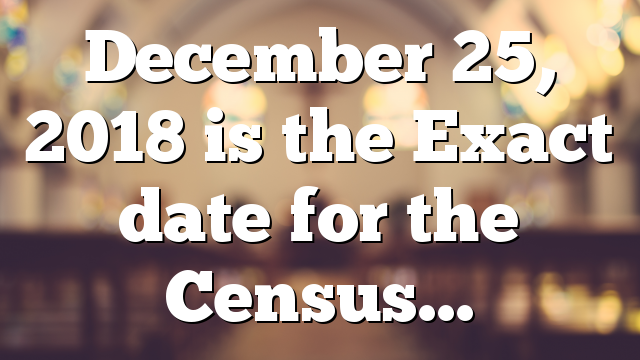Click to join the conversation with over 500,000 Pentecostal believers and scholars
Click to get our FREE MOBILE APP and stay connected
| PentecostalTheology.com



Exact date for the Census of Quirinius and JESUS
Posted in PentecostalTheology.com View the Original The Census of Quirinius was a census of Judea taken by Publius Sulpicius Quirinius, Roman governor of Syria, upon the imposition of direct Roman rule in Judea in 6 CE. To date, the only census documented outside the Bible near this time under … down to Bethlehem was the first census taken while Quirinius was governor of Syria. … does that imply that it is completely accurate, or does it contain insignificant …This census first took place while Quirinius was governing Syria. … The specific census which Luke mentions (Lk. 2:2), is that it “first took place This was the first census taken while Quirinius was governor of Syria. …. The words of Tertullian do not confirm or establish a specific date for the census
Listing the Facts
Let’s look at the Biblical passage in question and then we’ll take it apart to see what specific historical claims are made. “Now in those days a decree went out from Caesar Augustus, that a census be taken of all the inhabited earth. This was the first census taken while Quirinius was governor of Syria. And everyone was on his way to register for the census, each to his own city. Joseph also went up from Galilee, from the city of Nazareth, to Judea, to the city of David which is called Bethlehem, because he was of the house and family of David, in order to register along with Mary, who was engaged to him, and was with child. While they were there, the days were completed for her to give birth. And she gave birth to her firstborn son; and she wrapped Him in cloths, and laid Him in a manger, because there was no room for them in the inn.”(NASB)
In the Biblical account, we know these facts are presented:
- Caesar Augustus ordered a census
- Quirinius was governing Syria (hegemoneuontos tes Syrias Kyreniou)
- Each family must register at their familial city of origin
Further, Matthew chapter 2 reports that Herod the Great ordered the slaughter “all the male children who were in Bethlehem and all its vicinity, from two years old and under”(Matt 2:16). We know that Herod died 4-2 B.C., so Jesus birth had to have been before his death – most likely by two or more years. Given these facts, scholars generally date Jesus’ birth anywhere between 6 B.C. to 4 B.C.
Now, let’s turn our attention to the Josephus passage. In 17.13.5 of The Antiquity of the Jews, Josephus writes: “So Archelaus’ country was laid to the province of Syria; and Cyrenius, one that had been consul, was sent by Caesar to take account of people’s effects in Syria, and to sell the house of Archelaus.”1
From the Josephus account we derive the following facts:
- Caesar ordered a census
- Cyrenius (Quirinius) was sent to account for Syria and sell the house of Archelaus
- Cyrenius (Quirinius) “had been consul”
We also know from other historical records that Herod Archelaus was deposed in 6 A.D., so this census must be about 6 or 7 A.D. So, the question goes, if Herod the Great died in 4 B.C. and Josephus tells us Quirinius’ census wasn’t until 6 A.D., then isn’t this a contradiction?
More than One Census
Although on its face we seem to have a difficulty here, there are several pieces that we must consider before jumping to the conclusion that Luke and Josephus were speaking about the same event. Indeed, it seems that Caesar Augustus was the type of leader who ordered many censuses in his day. Records exist to show that Roman-controlled Egypt had begun a census as early as 10 B.C. and it was repeated every 14 years. And Augustus himself notes in his Res Gestae (The Deeds of Augustus) that he ordered three wide-spread censuses of Roman citizens, one in 28B.C., one in 8 B.C. and one in 14 A.D.2 In between there are several other censuses that happened locally across Rome. Luke’s account corroborates the idea of multiple censuses for Judea when he writes “This was the first census taken while Quirinius was governor of Syria.” Certainly, the word “first” implies that more than one census happened.
On another occasion, an enrollment of all the people of the empire happened to swear an oath of allegiance to Caesar. In Chapter 34 of Res Gestae Augustus also notes, “When I administered my thirteenth consulate (2 B.C.E.), the senate and Equestrian order and Roman people all called me father of the country, and voted that the same be inscribed in the vestibule of my temple”.3 Josephus also mentions a time “When all good people gave assurance of their good will to Caesar”.4 These types of tributes would also require an enrollment of individuals from across the empire. Orosius, a fifth century Christian, links this registration with the birth of Jesus saying that “all of the peoples of the great nations were to take an oath”.5
Taking all of this together, we have at least three censuses in the area of Judea – one in 8 B.C., one starting around 2 B.C. and one in 6 A.D. The only point that is really in question, then, is whether Luke was mistaken in ascribing this census to the time when Quirinius was in the role of Syrian Governor. Since Quirinius wasn’t governor of the Syrian province until after Archelaus was deposed, critics claim Luke misidentified the census as the smaller one, which happened some 8-10 years after Herod died. Either Luke is wrong on his dating of Jesus’ birth or Matthew made up the story of Herod the Great and the killing of the infants. Is this an accurate objection?
Subscribe to receive…




Guest;
The first mention of the December 25th date comes during the age of the martyrs. Bishop Hippolytus of Rome ( c. 170 AD – c. 235 AD) wrote a commentary on the Book of Daniel sometime around 202 AD in which he claimed: “The first coming of our Lord, that in the flesh, in which he was born at Bethlehem, took place eight days before the Kalends of January, a Wednesday, in the forty-second year of the reign of Augustus, 5500 years from Adam.” This puts the birth of Christ at December 25th, 2 BC. Julius Sextus Africanus claimed the same date in his Chronographiai, which was written around the same time as Hippolytus. Defamers of the December 25th date often suggest that Christians selected their date for Christ’s birth out of jealousy for the celebration of Saturnalia, a pagan festival which occurred around the same time. Had the December 25th date arisen in the fourth or fifth centuries, this argument might hold a little water. But consider for a moment that when Hippolytus and Africanus wrote, Christians were being persecuted by the Roman state. Hippolytus was ultimately martyred for Christ. The love which underwrites martyrdom is a love which cannot be tempted by the things of this earth. Is it reasonable to claim that this same Hippolytus was looking longingly at the things of the same Roman state which would ultimately slaughter him?
Guest;
There is no record of Sol Invictus being celebrated on December 25th until the 4th century. When critics of the December 25th date aren’t claiming Christmas was originally Saturnalia, they claim Christmas was originally Sol Invictus, a holiday celebrated in honor of the unconquerable sun. However, the first historical data suggesting Sol Invictus was celebrated on December 25th comes from the Chronography of 354, an illustrated calendar made for a rich Roman Christian named Valentinus. The holiday Sol Invictus instituted by Aurelian in 274 AD, but the imperial proclamation of the holiday comes with no fixed date. “The traditional feast days of Sol, as recorded in the early imperial fasti, were August 8th and/or August 9th, possibly August 28th, and December 11th,” writes Steven Hijmand in a remarkably well-written piece which can be read in full here. The first historical record of Sol Invictus being celebrated on December 25th comes two generations after the legalization of Christianity and more than 150 years after Christ’s birth was first dated to December 25th. In this, it is more likely that Sol Invictus is actually a co-opting of Christmas, not the other way around.
Isara Mo
Defence for Christmas.?
Varnel Watson
Isara Mo practically and particularly interested in the DATE – dec 25 seems to have the most BIBLICAL proof IMO The Puritans in the English Parliament eliminated Christmas as a national holiday in 1645, amid widespread anti-Christmas sentiment. Settlers in New England went even further, outlawing Christmas celebrations entirely in 1659. Anyone caught shirking their work duties or feasting was forced to pay a significant penalty of five shillings. Christmas returned to England in 1660, but in New England it remained banned until the 1680s, when the Crown managed to exert greater control over its subjects in Massachusetts. In 1686, the royal governor of the colony, Sir Edmund Andros, sponsored a Christmas Day service at the Boston Town House. Fearing a violent backlash from Puritan settlers, Andros was flanked by redcoats as he prayed and sang Christmas hymns.